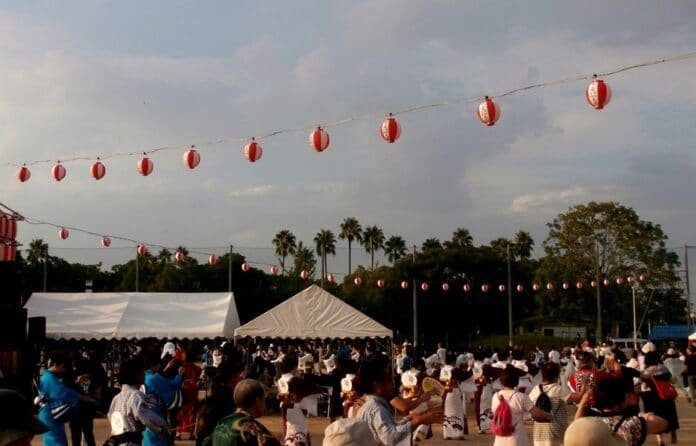
If you want to explore something different from Osaka City without going too far away, you’ve come to the right place. This is the third part of a series of articles on other parts of Osaka Prefecture that you might have overlooked. So far, I have talked about Ikeda and Sakai, but today we’ll be looking at two small cities southeast of Osaka: Yao and Fujiidera.
Table of Contents
Why you should go to Yao and Fujiidera
Positioned on either side of the Yamato River (Yamatogawa), the cities of Yao and Fujiidera are close to both Osaka and Sakai, and are about 15 minutes by train from Tennoji. Fewer people may live there than in bigger neighbouring cities – their combined population is only around 300,000 – but they have a rich history. In this article, I’ll share some information about this area through the ages and suggest some interesting sights to see, including ancient tombs, temples and local culture.
The history of Yao and Fujiidera
Yao and Fujiidera were only officially established as cities in the middle of the 20th century, but people have lived there for hundreds of years. Before the Meiji Restoration kick-started Japan’s modern era in 1868, this area was part of Kawachi Province. Far in the past, much of today’s Osaka Prefecture was underwater, especially in Kawachi Province, which shared its name with Kawachi Lake, a large body of water where Yao and other cities like Higashiosaka are today (read more about Osaka’s geographical changes here). The name “Kawachi” reflects this history too: the characters 河内 literally mean “within the river”. The geography later changed, but it remained a marshy area and became valuable for rice cultivation. The Yamato River, still one of the main rivers in the area, was also important to early Japanese government, as a transport route between the sea and several ancient capitals in the Nara region.

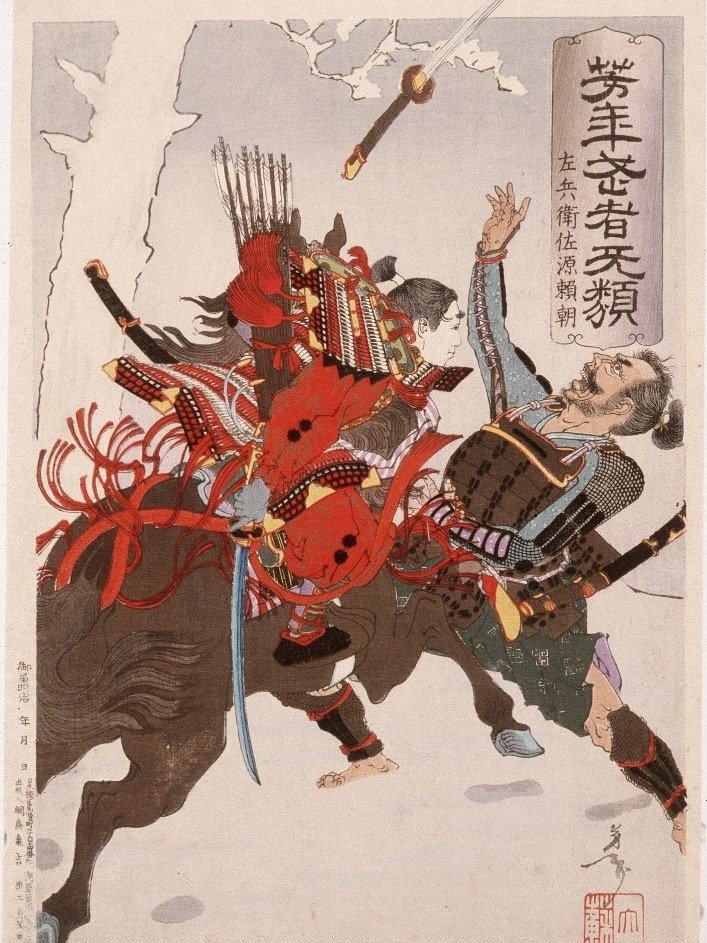
During the Nara Period, an era in the 8th century CE when the imperial capital was continuously at Heijo-kyo in modern-day Nara, one of Kawachi’s most notorious individuals was a Buddhist monk called Dokyo. Born into the Yuge clan in what is now Yao City, Dokyo became a powerful monk at the Heijo-kyo court during the reign of Empress Koken (also known as Empress Shotoku). After Dokyo cured the empress of an illness, he became increasingly known as a Rasputin-like figure, a close confidante of Koken and likely her lover. The court nobility would not allow Koken to marry, but Dokyo was given more and more important ranks and made enemies in the imperial court by attempting to manoeuvre himself into the throne. His efforts failed in the end, stirring up further opposition and prompting the empress to rule from a new imperial villa in Dokyo’s hometown for a while. After her death, Dokyo’s enemies regained their authority and had him banished to a distant province. Recently, archaeologists uncovered what may have been the foundations of Dokyo’s temple in Yao, but otherwise, a few small monuments are the only remaining physical evidence of this dramatic chapter of Kawachi history.
After the capital moved from Nara to Kyoto – supposedly due in part to the Dokyo affair – Kawachi Province declined in influence. For hundreds of years, political power in Japan was held by various clans, who frequently clashed with each other during civil wars. An influential clan based in this area was Kawachi-Genji, a branch of the Minamoto clan. They are best known as one side of the Genpei War, where they competed with the Taira clan for power (read more about the Genpei War here). Many important figures in the war came from the Kawachi-Genji branch, including Minamoto no Yoritomo, who became Japan’s first shogun, or military ruler, after the war. Later, Kawachi Province was also the site of many major battles during the Siege of Osaka, such as the Battle of Domyoji in today’s Fujiidera and Habikino. The Siege of Osaka was a crucial point in the power struggles that would eventually lead to the reunification of Japan, bringing an end to the longest period of civil war and ushering in the Edo Period: more than 200 years of relative peace.
The area of Osaka Prefecture was traditionally a wet region with rivers, lakes and canals, giving it a reputation as a “city of water”. Over the years, civil engineering projects rerouted many of these waterways to increase access to the sea and create more liveable land. Among these projects was the redirection of the Yamato River during the Edo Period. It previously ran from north to south through Kawachi Province and met other rivers north of Osaka Castle, but in the 18th century its path was changed, so that it now flows directly to the sea between Osaka and Sakai. This reduced flooding and made Kawachi even better for agriculture. The Yao area in particular became a major producer of cotton even well into the 20th century, when foreign imports began to dominate. The 20th century is also when the region was restructured from rural districts into cities, with Yao City being founded in 1948 as a merger of five existing towns and villages. Eleven years later, the towns of Domyoji and Fujiidera were merged to create today’s Fujiidera City.
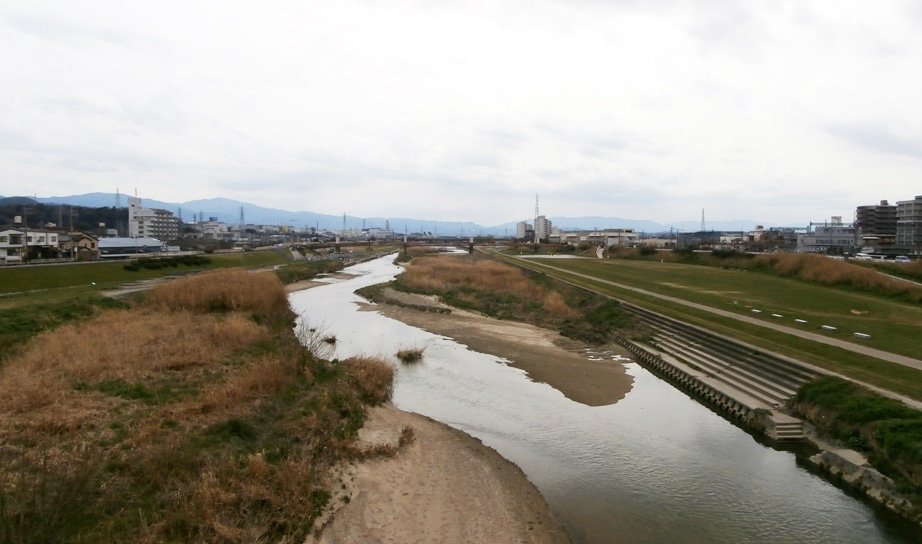
This gives you some idea of how Yao and Fujiidera came to be, but what is there to see if you visit today? In the next sections I’ll explore some of their main attractions.
Kofun in Fujiidera
Between the 3rd and 6th centuries CE, members of Japan’s ruling class were buried in tombs called kofun. These burial mounds, often in the shape of keyholes, are vital archaeological sites today. The Mozu-Furuichi group, consisting of dozens of the most important kofun, was inscribed as a UNESCO World Heritage Site in 2019. This group comprises two clusters: the Mozu cluster in Sakai City, and the Furuichi cluster, which can be found in Fujiidera and Habikino. The significance of the kofun in this area can be seen in the fact that Fujiidera City was briefly named Misasagi-cho, as misasagi is another word for an imperial tomb.
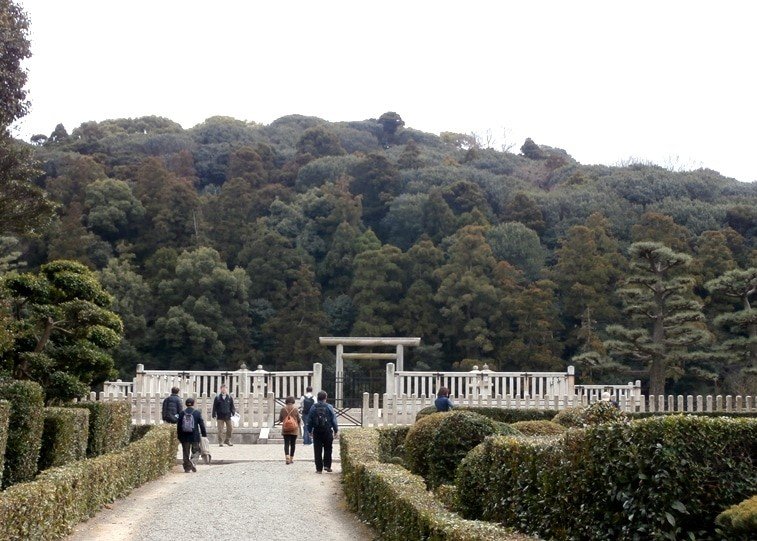

Some large kofun are surrounded by moats and inaccessible to the public. In Fujiidera, some tombs of this kind are claimed to enshrine possibly legendary individuals. These include Emperor Chuai, traditionally said to have reigned in the 2nd century, and Nakatsuhime-no-mikoto, supposedly the mother of Emperor Nintoku, whose own burial place is the enormous Daisenryo Kofun in Sakai. Even though visitors can’t cross the moats, it is fascinating to walk around and look at large kofun like these. Other kofun are public parks today – such as the Tsudo-Shiroyama Kofun, where rare bird-shaped terracotta figures have been excavated – letting you get up close with these impressive archaeological sites.
Temples and shrines
The two old towns that were merged to form Fujiidera City were each based around a Buddhist temple. Founded in 725 CE, Fujii-dera (to distinguish it from the city, I’ll use a hyphen when writing the name of the temple) is one of thirty-three spots in the Kansai region’s Saigoku Kannon Pilgrimage. The temples on this pilgrimage route are dedicated to Kannon, a popular bodhisattva who personifies compassion. The primary object of worship at Fujii-dera is Japan’s oldest known Thousand-Armed Kannon figure (senjukannon), which is designated as a National Treasure. Whereas other statues of this type are “thousand-armed” in name only, with many arms arranged to look like even more, this particular one is unique in that it actually has over one thousand arms. These hundreds of arms are said to allow Kannon to reach all people in need, while eyes painted on each palm allow this beloved deity to see suffering in the world. Fujii-dera’s Thousand-Armed Kannon is available for visitors to view once every month.
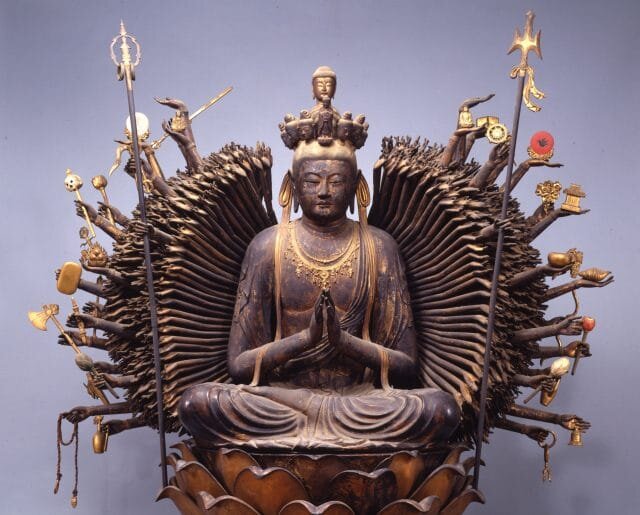
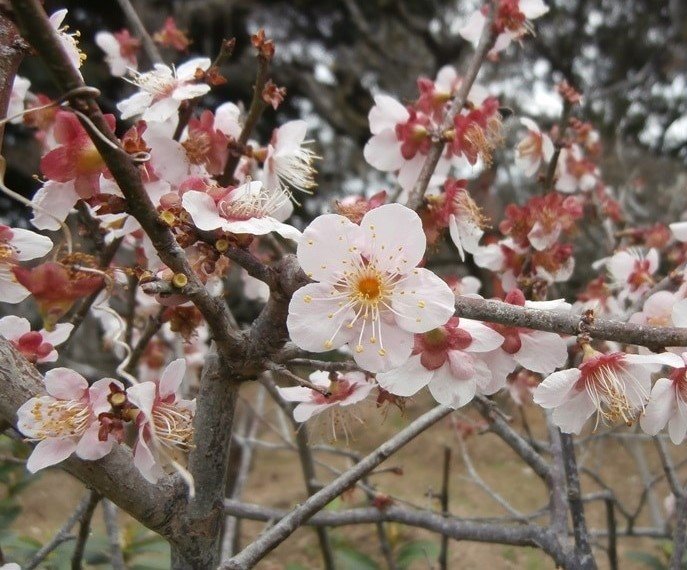
At the centre of Fujiidera’s other former town is Domyoji. Domyoji is known for having been the family temple of Sugawara no Michizane, who was an influential scholar at the court in Heian (Kyoto) during the 9th century. He famously came into conflict with important nobles who then had him exiled to Kyushu. After he died, several disasters occurred in Heian, prompting the imperial court to try and pacify his vengeful spirit by dedicating shrines to him and later deifying him as Tenjin. Today, Tenmangu shrines throughout Japan – such as Osaka Tenmangu, famous for Tenjin Matsuri in July – revere Tenjin, who is now mainly known as a deity of scholarship. Next to Domyoji is a Tenmangu shrine. As the temple and shrine are closely associated with the real-life Sugawara no Michizane, they are home to his only known relics. These include various personal effects at the shrine, and at the temple, a wooden Eleven-Faced Kannon statue believed to have been carved by the man himself. These relics are all recognised as National Treasures. Like many other Tenmangu shrines, Domyoji Tenmangu is also a popular plum blossom viewing spot. The trees in its extensive plum garden come into bloom every February.
Kawachi Ondo
Bon odori is a form of folk entertainment performed during the Obon festival all over Japan, in which locals and visitors dance in a circle around a wooden structure where the band plays. There are many famous local varieties of bon odori with distinctive music styles, including Kawachi Ondo, which originated in Yao. It is said that when the temple of Jokoji was being rebuilt in the 14th century, workers would sing while they carried timber from the Yamato River – which flowed through the Yao area in those days. Kawachi Ondo then evolved from those songs and became an important local tradition. A characteristic feature is the singing, which is slow and often features improvised lyrics, while the instrumentation can be eclectic, with modern-day performances borrowing from other genres such as rock and jazz.
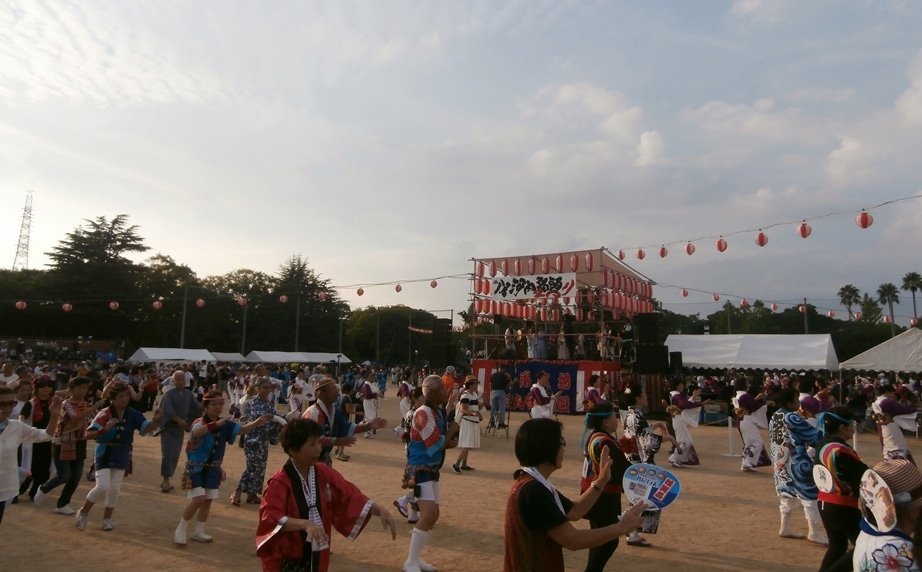

This popular community activity is still regularly performed in Yao today. One good way to experience it is at the annual Yao Kawachi Ondo Festival held in early September. You can take part in the Kawachi Ondo yourself, together with several local organisations who compete for prizes, and enjoy a variety of other entertainment and food. In 2017, the festival set a world record for the largest bon odori performance with 2872 participants. On the same day as the Yao Kawachi Ondo Festival, another local festival takes place in the nearby Kyuhoji neighbourhood. Decorative paper lanterns line the area’s traditional streets, temples and shrines throughout the evening, offering a relaxing break from the raucous atmosphere of Kawachi Ondo.
Access
It is possible to visit both Yao and Fujiidera in one day, but you may need to take more than one trip to see everything – especially seasonal events like plum blossom viewing at Domyoji Tenmangu or Kawachi Ondo.
The easiest way to access Kyuhoji Green Space, where the Yao Kawachi Ondo Festival is held, is by using the JR Yamatoji Line. Trains to Kyuhoji Station from Tennoji Station cost 180 yen and take under 10 minutes, and trains from Namba Station cost 220 yen and take about 20 minutes. The park is less than 10 minutes from the station’s north exit. Alternatively, the Kintetsu Osaka Line runs from Tsuruhashi to Kyuhojiguchi Station in about 15 minutes for 260 yen – to go all the way from Namba costs 300 yen and requires a transfer at Tsuruhashi or Fuse.
Only Kintetsu trains go to Fujiidera. To visit Fujii-dera, take a train from Abenobashi Station (at Tennoji) to Fujiidera Station on the Minamiosaka Line. It costs 300 yen and takes about 15 minutes on a semi-express train (note that local trains are much slower). For Domyoji, stay on the train for another few minutes and get off at Domyoji Station – the fare increases to 360 yen. Both temples are less than 5 minutes away from the nearest station. The kofun in Fujiidera are spread out around the city. The tombs of Emperor Chuai and Nakatsuhime-no-mikoto are a few minutes’ walk from Fujii-dera and Domyoji respectively, but some others will require you to explore a bit further.
To go between the two cities, you can take a number 70 Kintetsu bus from the north exit of Fujiidera Station. It takes about half an hour to travel between there and JR Yao Station – one stop from Kyuhoji – and costs 290 yen. Otherwise, the short Domyoji Line connects Domyoji Station to Kashiwara Station in about 5 minutes by train for 160 yen. At Kashiwara, you can get on the JR Yamatoji Line to access locations in Yao. This is more complicated than the bus, but may be more suitable depending on your plans.
All sightseeing spots mentioned in the article are free to visit, but there can be some additional fees. On the 18th of every month, you can see the Thousand-Armed Kannon at Fujii-dera for 500 yen. It also costs 500 yen to see the Eleven-Faced Kannon at Domyoji, available on the 18th and 25th. Domyoji Tenmangu has its plum blossom festival from mid-February to mid-March, during which you can visit the plum garden for 300 yen. At weekends during the festival and on other select days, Sugawara no Michizane’s relics can be seen, also for 300 yen.
As public sites, most of these locations have no opening hours, but hours for events or special areas may vary, so planning ahead is advised.
Except where otherwise noted, images are photographs taken by the author.





















